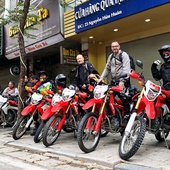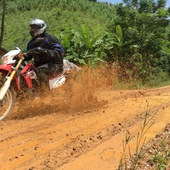Where to Go: Magnificent Motorcycle Routes Across Vietnam
These are some of the most popular routes in Vietnam and are beloved by those who traverse Vietnam by motorcycle.
Northern Vietnam
Ha Giang Loop
The Ha Giang Loop remains one of the most celebrated routes in Vietnam. Located in the northern region, Ha Giang shares a 145-mile border with China, and the province's iconic Ha Giang Loop is approximately a 6- to 11-hour drive (about 150 miles) from Hanoi, depending on traffic conditions. The trip to the loop itself is an adventure, with the primary road being 4C, often referred to as the "Road to Happiness."
Totaling around 190 miles, the loop typically requires at least four days to complete. Along the way, travelers will encounter breathtaking landscapes featuring towering limestone peaks, lush valleys, scenic caves, and captivating springs. Home to numerous ethnic minorities, including the H'Mong, Tay, and Lo Lo people, the region offers a rich tapestry of culture, history, and vibrant festivals. Market towns like Dong Van provide opportunities to immerse yourself in local life and experience the diverse culture up close.
Given the loop's numerous hairpin turns and winding mountain roads, it's advisable for experienced riders only. The best time to travel the loop is between October and May, as the weather can be unpredictable. Always prioritize safety and prepare for changing conditions.
Cao Bang
While traveling directly from Hanoi to Ha Giang is an option, consider taking a more scenic route through Cao Bang.
Cao Bang, located near the border of Ha Giang province, serves as a great base for exploring the surrounding areas. Like Ha Giang, it is also around a 6- to 11-hour drive (approximately 150 miles) from Hanoi. A recommended route is a loop northwest of Cao Bang city via DT 204, or head east to visit the magnificent Ban Gioc-Detian Falls, one of the major highlights in Northern Vietnam.
Ban Gioc-Detian Falls spans two countries—half of the waterfall lies in Vietnam and the other half in China, both perched along the Quay Son River and part of the UNESCO-recognized Non Nuoc Cao Bang Geopark.
Utilize the QL 34 road from Cao Bang town to Ha Giang town for a picturesque drive. It's essential to experience both Cao Bang and Ha Giang together to create unforgettable memories of your motorcycle trip across northern Vietnam.
Routes Not To Take In The North Of Vietnam
A particular motorcycle route to avoid in Northern Vietnam is from Hanoi to Ha Long Bay due to the hectic and tedious roads. If you plan to visit Ha Long Bay, consider storing your bike and taking a bus to avoid the stress of driving.
Central Vietnam
Hoi An to Hue
Both Hoi An and Hue are historic cities known for their well-preserved heritage. Hoi An, once a bustling fishing town, has a storied past as a significant trading port, while Hue was the imperial capital of Vietnam. The unique histories of both cities are reflected in their modern cultural practices and architecture. A drive from Hoi An to Hue is a must, with each location worthy of a multi-day visit. Besides the cities themselves, central Vietnam boasts beautiful landscapes worth exploring.
About an hour into your journey, you'll come upon Da Nang, one of Vietnam's largest coastal cities. This city exudes a slower pace compared to bustling Hanoi and Ho Chi Minh City, making it a perfect place to unwind for a few days. Take some time to enjoy the sun and the local attractions.
Between Hoi An and Da Nang lies the stunning Marble Mountains, filled with temples and natural beauty. These mountains also served as a hideout for the Viet Cong during the Vietnam War. Park your bike and explore the area on foot—a trek up the mountains involves climbing numerous stairs, so bring water and rest as needed. There are hidden trails and pathways waiting to be discovered, ensuring an enriching adventure.
Further north of Da Nang, the famous Hai Van Pass awaits, often celebrated as one of the world's most scenic drives. Its name translates to "Ocean Cloud Pass," inspired by the mist that occasionally rises from the nearby South China Sea.
This route offers winding roads coupled with mesmerizing views of the coast. As you ascend the mountains, the scenery transforms into lush jungles, a sight best savored at a leisurely pace.
Upon completing the Hai Van Pass, consider a stop at the idyllic Lang Co Lagoon or continue your journey to the historic town of Hue.
The optimal time for this drive is between January and June when the weather is more favorable. While the Hai Van Pass is only around 80 miles in length, the multitude of attractions along the way means travelers can easily spend five to six days enjoying this route.
Ho Chi Minh Trail
The Ho Chi Minh Trail is one of Vietnam's most notable routes. Its full extent is not clearly defined, but it serves as a historical link originating from an old supply line used during the war.
Starting in the south, the trail traverses through the center of the country. With lighter traffic, it proves to be a safer choice, although with over 200 miles to cover, it may require weeks of exploration. Plan your accommodations and breaks accordingly.
From Hue, access the Ho Chi Minh Trail easily via QL49 west toward Hong Quang, making it an ideal extension of your Hoi An to Hue journey.
As you travel north along the Ho Chi Minh Trail, the Phong Nha to Khe Sanh road will take you through Phong Nha Ke Bang National Park. If you can, make a stop here, as the park is home to the world's largest cave, Son Doong.
Another striking part of the Ho Chi Minh Trail features the QL14 road from Prao to Phong Nha, showcasing central Vietnam's breathtaking scenery. Prao is located about 45 miles (3-4 hours) west of Da Nang via QL14G road.
This section of the trail reveals stunning mountain vistas, winding rivers, lush green jungles, and impressive bridges to cross.
The best conditions to tackle the Ho Chi Minh Trail are generally between March and September. However, since it crosses various weather systems within Vietnam, be sure to check forecasts and stay prepared for changes.
Despite its remote sections, the Ho Chi Minh Trail is well-maintained and accessible making it a top choice for any motorcycle enthusiast looking to explore Vietnam.
Southern Vietnam
Home to the Mekong Delta and Ho Chi Minh City (Saigon), Southern Vietnam represents the country’s most populous region. As you navigate through southern Vietnam, you’ll notice the rapid changes in scenery and culture as one town quickly transitions into another. Starting your journey from Saigon, escape the urban sprawl by heading northeast.
Cat Tien to Dalat
Cat Tien National Park, situated roughly 70 miles (4-8 hours) north of Saigon, serves as an excellent starting point for a motorcycle adventure in southern Vietnam. Formerly a dense tropical forest, the park has transformed primarily into bamboo and grassland, offering easy navigation.
From Cat Tien, the DT725 road leads you to the charming mountain town of Dalat. This route reveals picturesque lakes and forests, renowned by travelers. Near Dalat, the DT725 merges with the QL27 highway; after a brief stretch, the DT725 resumes into Dalat.
Once a colonial retreat, Dalat is now famous for its flowers, distinctive architecture, and serene atmosphere. The entire 130-mile journey is doable in a day or two, but for a more enjoyable experience, dedicate at least four days to truly soak in the stunning landscapes and fresh air.
The descent from Dalat to the beach town of Nha Trang provides another beautiful drive that can easily be completed within a day. Nha Trang is an excellent base for further exploration of central Vietnam.
Mui Ne to Nha Trang
The coastal town of Mui Ne has evolved from an old fishing village into a popular tourist destination, with charming resorts and beautiful beaches. Its strategic position in southern Vietnam makes it a great starting point for exploration.
The coastal route from Mui Ne to Nha Trang offers breathtaking views and is approximately 180 miles long; anticipate taking a few days to complete this journey. When traveling in the area, it is recommended to avoid the busy QL1A highway. Although this road connects Mui Ne to Nha Trang, it lacks the scenic appeal you might desire.
A better alternative is the DT716, which offers a more picturesque journey along the coastline. After traveling on the DT716, a brief segment on the QL1A will suffice until you can switch back to the coastal route along Duong Van Bien Ninh Thuan. This road weaves through hilly terrains right by the ocean and continues into the DT 702, celebrated for its stunning vistas among motorbike travelers. This leg takes you closest to the ocean, providing a true sense of freedom on your motorcycle.
The route concludes in Cam Ranh, just south of Nha Trang, where you can easily reach your final destination.
Routes Not To Take In The South Of Vietnam
While exploring the southern region, it’s prudent to avoid the Mekong Delta. Its chaotic congestion and pollution may create unnecessary stress during your travels.
Another area to skip is Vung Tau, a beach town located about a 6-hour drive southeast of Saigon. Though often worth visiting, the road leading to Vung Tau from Saigon is heavily congested and polluted. Instead, consider storing your motorcycle in Saigon and taking a high-speed ferry to this coastal haven.
Time frame
When planning your journey, you can customize it to fit your schedule. If time is of the essence, focus on one specific region and explore it thoroughly—each area can be comfortably covered in about two weeks.
For a more comprehensive experience, consider a two-month exploration from north to south or vice versa. It's an adventure you’ll recount for years to come.

Before You Go: Getting Prepared for the Ride of Your Life
If you are brave enough, a motorbike adventure to mountainous area may be a great way to experience Vietnam.

Motorbike Rental - The Basics
All you need to know about renting a motorbike in Vietnam

Traveling By Motorbike In Mountainous Areas in Vietnam
Motorbike is considered a favorite means of transportation for traveling mountainous areas for many adventurers.








